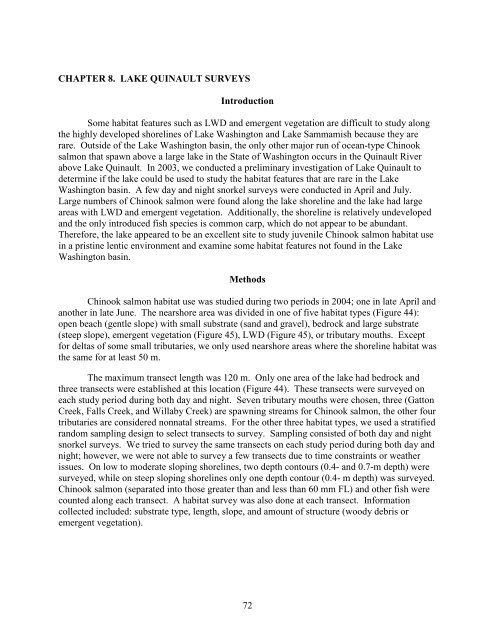Nearshore Habitat Use by Juvenile Chinook Salmon in Lentic ...
Nearshore Habitat Use by Juvenile Chinook Salmon in Lentic ...
Nearshore Habitat Use by Juvenile Chinook Salmon in Lentic ...
You also want an ePaper? Increase the reach of your titles
YUMPU automatically turns print PDFs into web optimized ePapers that Google loves.
CHAPTER 8. LAKE QUINAULT SURVEYS<br />
Introduction<br />
Some habitat features such as LWD and emergent vegetation are difficult to study along<br />
the highly developed shorel<strong>in</strong>es of Lake Wash<strong>in</strong>gton and Lake Sammamish because they are<br />
rare. Outside of the Lake Wash<strong>in</strong>gton bas<strong>in</strong>, the only other major run of ocean-type <strong>Ch<strong>in</strong>ook</strong><br />
salmon that spawn above a large lake <strong>in</strong> the State of Wash<strong>in</strong>gton occurs <strong>in</strong> the Qu<strong>in</strong>ault River<br />
above Lake Qu<strong>in</strong>ault. In 2003, we conducted a prelim<strong>in</strong>ary <strong>in</strong>vestigation of Lake Qu<strong>in</strong>ault to<br />
determ<strong>in</strong>e if the lake could be used to study the habitat features that are rare <strong>in</strong> the Lake<br />
Wash<strong>in</strong>gton bas<strong>in</strong>. A few day and night snorkel surveys were conducted <strong>in</strong> April and July.<br />
Large numbers of <strong>Ch<strong>in</strong>ook</strong> salmon were found along the lake shorel<strong>in</strong>e and the lake had large<br />
areas with LWD and emergent vegetation. Additionally, the shorel<strong>in</strong>e is relatively undeveloped<br />
and the only <strong>in</strong>troduced fish species is common carp, which do not appear to be abundant.<br />
Therefore, the lake appeared to be an excellent site to study juvenile <strong>Ch<strong>in</strong>ook</strong> salmon habitat use<br />
<strong>in</strong> a prist<strong>in</strong>e lentic environment and exam<strong>in</strong>e some habitat features not found <strong>in</strong> the Lake<br />
Wash<strong>in</strong>gton bas<strong>in</strong>.<br />
Methods<br />
<strong>Ch<strong>in</strong>ook</strong> salmon habitat use was studied dur<strong>in</strong>g two periods <strong>in</strong> 2004; one <strong>in</strong> late April and<br />
another <strong>in</strong> late June. The nearshore area was divided <strong>in</strong> one of five habitat types (Figure 44):<br />
open beach (gentle slope) with small substrate (sand and gravel), bedrock and large substrate<br />
(steep slope), emergent vegetation (Figure 45), LWD (Figure 45), or tributary mouths. Except<br />
for deltas of some small tributaries, we only used nearshore areas where the shorel<strong>in</strong>e habitat was<br />
the same for at least 50 m.<br />
The maximum transect length was 120 m. Only one area of the lake had bedrock and<br />
three transects were established at this location (Figure 44). These transects were surveyed on<br />
each study period dur<strong>in</strong>g both day and night. Seven tributary mouths were chosen, three (Gatton<br />
Creek, Falls Creek, and Willa<strong>by</strong> Creek) are spawn<strong>in</strong>g streams for <strong>Ch<strong>in</strong>ook</strong> salmon, the other four<br />
tributaries are considered nonnatal streams. For the other three habitat types, we used a stratified<br />
random sampl<strong>in</strong>g design to select transects to survey. Sampl<strong>in</strong>g consisted of both day and night<br />
snorkel surveys. We tried to survey the same transects on each study period dur<strong>in</strong>g both day and<br />
night; however, we were not able to survey a few transects due to time constra<strong>in</strong>ts or weather<br />
issues. On low to moderate slop<strong>in</strong>g shorel<strong>in</strong>es, two depth contours (0.4- and 0.7-m depth) were<br />
surveyed, while on steep slop<strong>in</strong>g shorel<strong>in</strong>es only one depth contour (0.4- m depth) was surveyed.<br />
<strong>Ch<strong>in</strong>ook</strong> salmon (separated <strong>in</strong>to those greater than and less than 60 mm FL) and other fish were<br />
counted along each transect. A habitat survey was also done at each transect. Information<br />
collected <strong>in</strong>cluded: substrate type, length, slope, and amount of structure (woody debris or<br />
emergent vegetation).<br />
72
















